Book contents
- Frontmatter
- Preface
- Contents
- 1 Preliminaries
- 2 Basic Concepts in Metric Spaces
- 3 Sequences in Metric Spaces
- 4 Limits and Continuity
- 5 Completeness
- 6 Compactness
- 7 Connectedness
- 8 Approximations
- 9 Fixed Point Theorems and Their Applications
- 10 A Construction of Real Number System
- Appendix A Definition of Sets as Cumulative Type Structures
- Appendix B Bibliography
- Index
7 - Connectedness
Published online by Cambridge University Press: 05 April 2012
- Frontmatter
- Preface
- Contents
- 1 Preliminaries
- 2 Basic Concepts in Metric Spaces
- 3 Sequences in Metric Spaces
- 4 Limits and Continuity
- 5 Completeness
- 6 Compactness
- 7 Connectedness
- 8 Approximations
- 9 Fixed Point Theorems and Their Applications
- 10 A Construction of Real Number System
- Appendix A Definition of Sets as Cumulative Type Structures
- Appendix B Bibliography
- Index
Summary
If from the real line ℝ, the irrational numbers are dropped, it becomes a line with holes which is what we call the subspace of rational numbers. Intuitively, the absence of holes in the real line makes it a single piece while rationals are not a single piece. If we drop the origin (0, 0) from the 2-dimensional Euclidean space ℝ2, it still remains a single piece while the removal of the y-axis will make two pieces of ℝ2, viz. the right half plane and the left half plane. The property of being a single piece is very important in mathematical analysis, and is known as connectedness. All intervals in the real line ℝ share this property. Thus, the real line is connected while the set of rational numbers is not. The metric spaces ℝ2, ℝ2 - {(0, 0)} are connected while ℝ2 minus y-axis is not connected. It will be seen that the famous intermediate value theorem: If f : [a, b] → ℝ is a continuous function, and f(a) ≤ c ≤ f(b), then there exists a x in [a, b] such that f(x) = c, depends not only on the continuity of f but also on the property of connectedness of the interval [a, b]. Though the property of connectedness is quite intuitive, it requires some effort to formulate it precisely in mathematical terms, and so the reader is advised to have a little patience.
Information
- Type
- Chapter
- Information
- First Course in Metric Spaces , pp. 279 - 304Publisher: Foundation BooksPrint publication year: 2010
